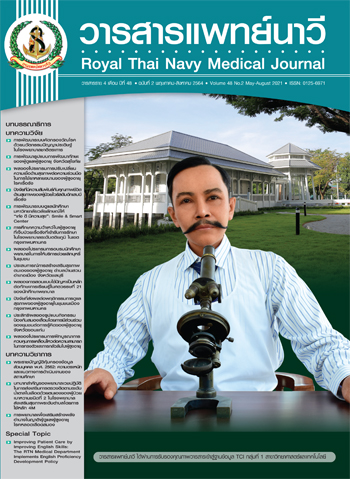ผลของโปรแกรมฝึกบูรณาการควบคุมการเคลื่อนไหวต่อความสามารถในการทรงตัวและการกลัวล้มในผู้สูงอายุ
Main Article Content
บทคัดย่อ
การวิจัยนี้มีวัตถุประสงค์เพื่อพัฒนาโปรแกรมการฝึกบูรณาการควบคุมการเคลื่อนไหว และเปรียบเทียบความสามารถในการทรงตัวและการกลัวล้ม ระหว่างกลุ่มทดลองที่ใช้โปรแกรมที่พัฒนาขึ้นกับกลุ่มควบคุมที่ใช้โปรแกรมออกกำลังกายทั่วไป กลุ่มตัวอย่างเป็นผู้สูงอายุเพศหญิง มีช่วงอายุ 61 - 83 ปี ในเขตอำเภอเมืองระยอง จังหวัดระยอง จำนวน 60 คน แบ่งเป็นกลุ่มทดลอง 30 คน และกลุ่มควบคุม 30 คน ใช้แบบแผนการวิจัยแบบวัดก่อนและหลังการทดลองแบบมีกลุ่มควบคุม วัดความสามารถในการทรงตัวโดยแบบประเมินการทรงตัว และประเมินการกลัวล้มโดยใช้แบบประเมินการกลัวล้ม วิเคราะห์ข้อมูลทางสถิติด้วยวิธีการหาค่าความถี่ ร้อยละ ค่าเฉลี่ย ส่วนเบี่ยงเบนมาตรฐาน และสถิติทดสอบที (t-test) สำหรับกลุ่มตัวอย่างทั้งสองกลุ่ม ผลการวิจัยพบว่า กลุ่มทดลองที่ใช้โปรแกรมการฝึกบูรณาการควบคุมการเคลื่อนไหว มีความสามารถในการทรงตัวเพิ่มขึ้นมากกว่ากลุ่มควบคุม อย่างมีนัยสำคัญทางสถิติที่ระดับ .05 และกลุ่มที่ใช้โปรแกรมการฝึกบูรณาการควบคุมการเคลื่อนไหว พบว่า มีคะแนนมากกว่ากลุ่มควบคุม อย่างมีนัยสำคัญทางสถิติที่ระดับ .05
Article Details

อนุญาตภายใต้เงื่อนไข Creative Commons Attribution-NonCommercial-NoDerivatives 4.0 International License.
เอกสารอ้างอิง
Chatterji S, Byles J, Cutler C, Seeman T, Verdes E. Health, functioning, and disability in older adults-present status and future implications. Lancet 2015;385(9967):563-75.
Al-Aama T. Falls in the elderly: spectrum and prevention. Can Fam Physician 2011;57(7):771-6.
Tanuchit S, Chinnacom D, Malathong N, Doungthipsirikul S, Tantivess S. Recommendations for emergency medical service for the elderly in Thailand: a research report. Nonthaburi: National Institute of Emergency Medicine; 2017. (in Thai).
Greenberg MR, Moore EC, Nguyen MC, Stello B, Goldberg A, Barraco RB, et al. Perceived fall risk and functional decline: gender differences in patient's willingness to discuss fall risk, fall history, or to have a home safety evaluation. Yale J Biol Med 2016;89(2):261-7.
Muangpaisan W, Suwanpatoomlerd S, Srinonprasert V, Sutipornpalangkul W, Wongprikron A, Assantchai P. Causes and course of falls resulting in hip fracture among elderly Thai patients. J Med Assoc Thai 2015;98(3):298-305. (in Thai).
Moreno-García A, Kun A, Calero O, Medina M, Calero M. An overview of the role of Lipofuscin in age-related neurodegeneration. Front Neurosci 2018;12(464):1-13.
Murman DL. The impact of age on cognition. Semin Hear 2015;36(3):111-21.
Oshima Y, Watanabe N, Takai S, Kawata M. Abnormal posture relating to the alignment of spine and lower extremity. [Internet]. [cited 2021 March 1]. Available from: https://downloads.hindawi.com/journals/aorth/2019/8460364.pdf.
Henry M, Baudry S. Age-related changes in leg proprioception: implications for postural control. J Neurophysiol 2019;122(2):525-38.
Tamsa A, Aree-Ue S, Leelacharas S. Fear of falling and functional ability in older adults undergoing hip surgery. JOPN 2015;7(1):64-82. (in Thai).
Meetam T, Sritan P, Thongprong T. The changes of temporospatial gait parameters during treadmill walking at preferred speed with and without song searching task. Thai Journal of Physical Therapy 2017;39(2):39-51. (in Thai).
Soontorntai P, Phakdepiboon T, Sanjaroensuttikul N, Sinithanon R. Efficacy of beguine dance on balance in elderly Thais with a history of fall. J Thai Rehabil Med 2016;26(2):61-6. (in Thai).
Ng CACM, Fairhall N, Wallbank G, Tiedemann A, Michaleff ZA, Sherrington C. Exercise for falls prevention in community-dwelling older adults: trial and participant characteristics, interventions and bias in clinical trials from a systematic review. BMJ Open Sport Exerc Med 2019;5(1):e000663. doi: 10.1136/bmjsem-2019-000663.
Langhammer B, Bergland A, Rydwik E. The importance of physical activity exercise among older people. Biomed Res Int 2018 Dec 5;2018:7856823. doi: 10.1155/2018/7856823.
Suwan P, Kanthanaphat N, Soawaphan J, Intarasongkor S, Uonkeaw A, Hankla S. The development of practice guideline for preventing fall using 10 P’s multifactorial concepts among older adults in community. Royal Thai Navy Medical Journal 2020;47(2):414-31. (in Thai).
Kisner C, Colby LA. Therapeutic exercise. 5th ed. Philadephia: Margaret Biblis; 2007.
Umphred DA, Lazaro RT, Roller M, Burton G. Neurological rehabilitation. 6th ed. St. Louis: Elsevier Health Sciences; 2013.
Ngowtrakul B, Chadcham S, Kaewkaen P. Increasing lower extremity muscle strength and the speed of sit-to-stand by using a motor imagery control combined with exercise program in older adults: an EEG study. Research Methodology & Cognitive Science 2017;15(2):53-68. (in Thai).
Noohu MM, Dey AB, Hussain ME. Relevance of balance measurement tools and balance training for fall prevention in older adults. Journal of Clinical Gerontology and Geriatrics 2014;5(2):31-5.
Shaffer SW, Harrison AL. Aging of the somatosensory system: a translational perspective. Physical Therapy 2007;87(2):193-207.
Podsiadlo D, Richardson S. The timed “Up & Go”: a test of basic functional mobility for frail elderly persons. J AM Geriatr Soc 1991;39(2):142-8.
Thiamwong L. Psychometric testing of the Falls Efficacy Scale-International (FES-I) in Thai older adults. Songkla Med J 2011;29(6):277-87. (in Thai).
Nokham R, Panuthai S, Khampolsiri T. Effect of square-stepping exercise on balance among older persons. Nursing Journal 2016;43(3):58-68.
Redfern MS, Jennings JR, Martin C, Furman JM. Attention influences sensory integration for postural control in older adults. Gait & Posture 2001;14(3):211-6.
Wannapakhe J, Kongpijitwong P, Lomsomboon S, Thongprasart A. Comparison of physical abilities in elderly with and without fear of fall. J Med Tech Phy Ther 2018;30(1):70-80. (in Thai).
St Jacques P, Dolcos F, Cabeza R. Effects of aging on functional connectivity of the amygdala during negative evaluation: a network analysis of fMRI data. Neurobiol Aging 2010;31(2):315-27.


